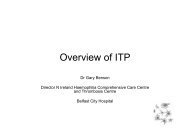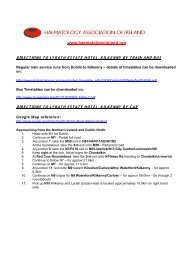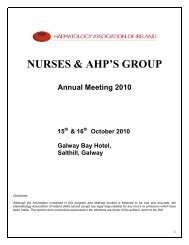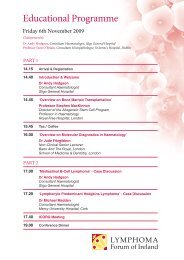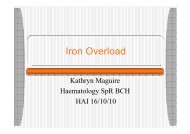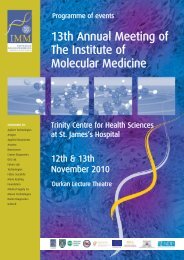Guidelines on Diagnosis and Treatment of Malignant Lymphomas
Guidelines on Diagnosis and Treatment of Malignant Lymphomas
Guidelines on Diagnosis and Treatment of Malignant Lymphomas
Create successful ePaper yourself
Turn your PDF publications into a flip-book with our unique Google optimized e-Paper software.
CODOX-M, (3 cycles) for low risk disease <strong>and</strong> CODOX-M/IVAC<br />
(2 cycles) for high risk disease is the current treatment <strong>of</strong> choice.<br />
Dose intensity is vital for optimal outcome <strong>and</strong> treatment should<br />
be given in full doses without delays. Cure rates with this<br />
approach are 90% for low risk disease <strong>and</strong> 60% for high risk<br />
disease. There is no r<strong>and</strong>omised c<strong>on</strong>trol trial evidence for the<br />
additi<strong>on</strong> <strong>of</strong> Rituximab; however it is active in BL <strong>and</strong> its use is<br />
logical. Patients who relapse generally die <strong>and</strong> there is no proven<br />
indicati<strong>on</strong> for high-dose treatment strategies.<br />
Resp<strong>on</strong>se Evaluati<strong>on</strong><br />
The key factor is to deliver treatment with maintenance <strong>of</strong><br />
dose intensity. The patient should be assessed with CT scan,<br />
BM aspirate <strong>and</strong> CSF after the first course <strong>of</strong> chemotherapy<br />
to ensure remissi<strong>on</strong>. At the end <strong>of</strong> treatment, tests which<br />
were abnormal at diagnosis such as CT scan, b<strong>on</strong>e marrow<br />
or CSF examinati<strong>on</strong> should be repeated.<br />
Follow Up<br />
Relapse is usually seen within <strong>on</strong>e year <strong>and</strong> patients remaining<br />
free <strong>of</strong> disease at two years can be c<strong>on</strong>sidered cured. Rare<br />
late “relapses” due to the evoluti<strong>on</strong> <strong>of</strong> a sec<strong>on</strong>d BL cl<strong>on</strong>e<br />
have been described.<br />
M<strong>on</strong>thly follow up for first 6 m<strong>on</strong>ths, 2 m<strong>on</strong>thly for 6 m<strong>on</strong>ths,<br />
4 m<strong>on</strong>thly for a year <strong>and</strong> then annual follow up is recommended,<br />
with particular attenti<strong>on</strong> to late effects.<br />
Female patients usually maintain fertility following CODOX-<br />
M/IVAC but the fertility outcome for post-pubertal males<br />
is unclear.<br />
40



